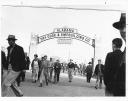By Bryan Newbury
September 26, 2007
Good popular music can follow any of a number of paths to achieving momentary success. Great popular music must navigate choppier waters. One of the essential disciplines for a great pop album is song placement. The artist and producer weave a complex, but in many ways predictable, emotional pattern. Song placement is key in this endeavor. Almost always, the great album peaks at song four. There is no way of explaining it. Whether it is ten songs or thirteen, whether pensive or exuberant, the key song is always positioned at number four. For the skeptical, the following apply: 1. Everybody Hurts; 2. Thirteen; 3. Veronica; 4. This Is Hell. Elvis Costello occupies two spots.
Rubber Soul and Pet Sounds notwithstanding, it holds true more often than not. Apparently, the same applies to sprawling documentary work.
The War’s Episode Three is that perfect tune. It isn’t necessarily the hit, but it is certainly the piece of work that will stand out thirty years from now, justifying the importance of the project. Like so many of those pieces of music, there isn’t a definitive explanation for why it is exceptional, especially in comparison to the other pieces comprising the whole, but almost everyone eventually accepts the supposition.
It isn’t hard to accomplish tension and emotional upheaval when your subject is World War II. Manipulating those elements into rising and falling action, therefore, is a thankless task. It is expected, despite the difficulty it entails.
Episode Three throws in the kitchen sink.
We begin with racial tension. There is a need for delicacy here. We all know, whether we choose to admit it or not, that the United States in the 1940’s was far from an egalitarian example. The War points out not only the segregation of the Jim Crow South, and the discrimination faced by African-Americans in both the military and civilian world, but also the continuing saga of Japanese-Americans (as a matter of proportion, notice we can say “Japanese†rather than “Asian†American) in the tumult of our battle against the Axis Powers. The delicacy required pertains to the apparent dichotomy of a country that played a major role in defeating fascism while simultaneously denying basic rights to its minority communities.
Much is made of American exceptionalism. It is hard to controvert, considering men like Daniel Inouye of Hawai’i. As the American military displays the gall to recruit in internment camps for the new 442nd Regimental Combat Team (a segregated, Japanese unit allowed to join—or exhibit treason, should they refuse—the fight in 1943) Inouye’s father tells him that “This country has been good to us… we owe a lot to this country… do not dishonor this country.†Where else can a country expect loyalty from those who find themselves incessantly under the boot of their betters? As The War depicts over and over again, this loyalty is obviously in earnest. Without the efforts of the segregated regiments, it would have been difficult at best to prevail. Somehow, America earned their trust more than its majority population.
If the viewer expected to be spared the importance of collective sacrifice, think again. As we segue from those brave men of Senegambian and Japanese, along with Anglo, German and Italian, etc., extraction, another bit of oblique history is accented. In Episode Two it is made quite clear that, rather than strategy or expertise, sheer overproduction was key to victory. Episode Three illustrates another key to victory: recycling. The question is obvious. When was the last time we were asked to save our kitchen fats? Take one less spoon of sugar? Hell, nowadays it would cause a rebellion if we spared a few thousand Congolese lives to do without the same amount of Play Stations. Point taken.
Issues of mutual effort and ethnic inequality eventually give way to those personal stories Burns hinges the entire series upon. While we’re throwing in the kitchen sink… well, let us say that Babe Ciarlo’s correspondence reaches climax.
More and more, The War reminds us of The Old Testament. While absorbing it, we observe that much of it is scattered, irritating and absurd. And, in some inexplicable way, absolutely necessary for all projects of its kind to follow.
—–
Click here to read all of Newbury’s writing on The War.
A film by Ken Burns
Color and Black & White, 2007
 If Herodotus is history’s father, we might nominate Celine his counterpart in terms of twentieth century war analysis. As he recounts his experiences with the World Wars, as a soldier, citizen and sometime refugee, the primary component… aside from war’s mindlessness, brutality and exacerbating class divide… of his evaluation comes down to a sense of randomness.
If Herodotus is history’s father, we might nominate Celine his counterpart in terms of twentieth century war analysis. As he recounts his experiences with the World Wars, as a soldier, citizen and sometime refugee, the primary component… aside from war’s mindlessness, brutality and exacerbating class divide… of his evaluation comes down to a sense of randomness.


